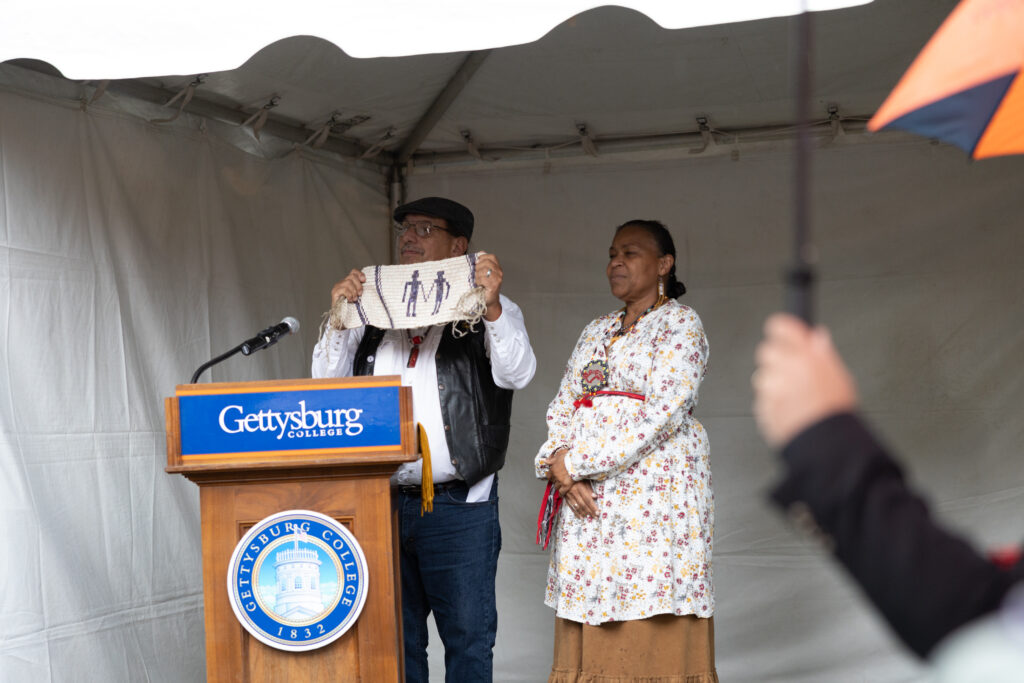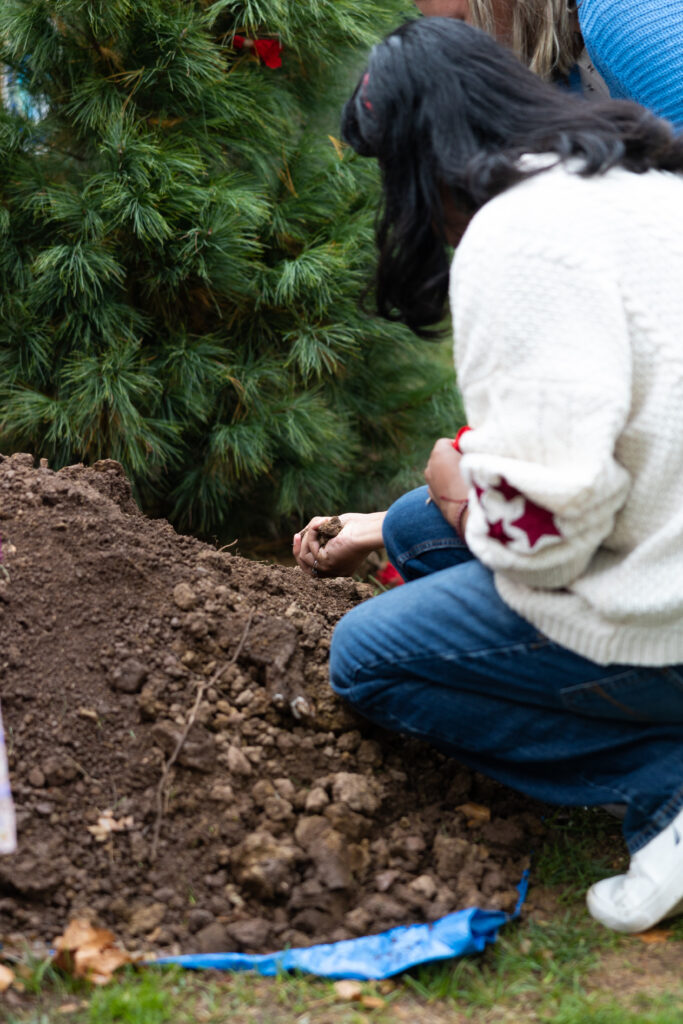Land Acknowledgement Dedication Recognizes Important Connections Between the College and Indigenous Culture
By Sophie Lange, Staff Writer
On Oct. 13 at 4 p.m., the Land Acknowledgement Dedication Ceremony took place on the South Lawn of Penn Hall. It was sponsored by the Land Acknowledgement Committee and the Center for Public Service with support from the Students for Indigenous Awareness; Gettysburg Environmental Concerns Organization; Peace and Justice; the Offices of the President, Diversity, the Provost, the Eisenhower Institute, College Life, Religious Life, Musselman Library, Garthwait Leadership Center, and EPACC; and the Departments of Environmental Studies, Biology, Sociology, Peace & Justice Studies, Anthropology, English, and Women, Gender & Sexuality Studies.
The ceremony opened with a greeting from President Bob Iuliano. He expressed the importance of the ceremony in the history of Gettysburg College, as well as the need to preserve and care for the land.
He also welcomed the ceremony’s honored guests: MaryAnn Robins, Onondaga of the Haudenosaunee Confederacy, and President of the Circle Legacy Center; Barry Lee, Munsee Lenape, and executive director of the Circle Legacy Center; Sandi Cianculli, Oglala Lakota, and President of the Carlisle Indian School Project; A’lice Myers Hall, Lenape Indian Tribe of Delaware, and President of the American Indian Society of Washington D.C.; Shelia Hanson, Shawnee and Lenape, and Vice President of the American Indian Society of Washington D.C.; Curtis Zunigha, Lenape Delaware Tribe of Indians of Oklahoma, Co-Director of the Lenape Center in New York; Michael Nephew, Eastern Band of Cherokee and Cayuga-Seneca descendent, Vice President of the American Indian Society of Washington D.C.

Two of the honored guests speak at the Land Acknowledgement Dedication on Oct. 13, 2022 (Photo Eric Lippe/The Gettysburgian).
Iuliano stated, “It is this land that continues to sustain and inspire all of us today as its caretakers. This matters to us. We have a responsibility to preserve this knowledge and these values for generations to come which is why dedications like this are so important.”
After his opening remarks, Iuliano asked several alumni and current students, all of whom had been involved in Students for Indigenous Awareness, to come forward to recite the Land Acknowledgement Statement, which states:
“Gettysburg College is on unceded, Indigenous land including the traditional homelands of the Susquehannock/Conestoga, Seneca and the Haudenosaunee Confederacy, Leni Lenape, and Shawnee Nations, and the connections of Indigenous peoples to this land continue today. We have a responsibility to honor these connections, and we strive to understand our place within the past, present, and future of this Indigenous land by reflecting on our relationships with the human and other-than-human relatives with whom it is shared.”
This Land Acknowledgement was adopted in 2021, arising from many partnerships across campus, but had been in the works since 2016, when a group of students started the initiative.
After the recitation of the statement, the honored guests were welcomed forward to speak. Common themes throughout their speeches were the concepts of stewardship, belonging, and respect for the Earth and one another.
Lee emphasized the idea that “we all belong” when he spoke to the audience.
Then, the focus turned to the planting of the Tree of Peace: a white pine. It holds symbolic meaning to Indigenous people, which was why it was chosen for the dedication. The five needles represent the Five Nations of the confederacy. The first Tree of Peace had four roots extending in all four directions to invite all people to live in peace.

Students help plant the Tree of Peace at the Land Acknowledgement Dedication on Oct. 13, 2022 (Photo Eric Lippe/The Gettysburgian).
Next, attendees were invited to place Sacred Tobacco, representing healing, from the Leni Lenape, in addition to adding a handful of soil to plant the tree.
According to Environmental Studies Chairperson and Professor Salma Monani, this ceremony took a significant level of planning. She and Religious Studies Associate Professor David Walsh, both co-coordinators of the Land Acknowledgement Committee, worked with many others from the committee to decide the process. However, the Native partners initiated this idea. Though many institutions throughout the United States have held similar ceremonies, a ceremony at Gettysburg College was particularly meaningful due to its location in the eastern U.S.
Monani explained, “On the east, it’s much less [common] because the Indigenous erasure has persisted for much longer.”
The Land Acknowledgement Committee looked for support on campus for the ceremony while inviting the Native partners to decide what should be included in the ceremony. The committee hosted a listening session before the ceremony to include as many people as possible in its planning.
Monani and Walsh were very interested in having representation from all of the Indigenous groups named in the Land Acknowledgement Statement, involving both individuals and formally-recognized tribal governments.
Monani also discussed the mission of the Land Acknowledgement Statement, remarking that, “[It is] not just there are Indigenous people here, but that there are Indigenous people here and what do we do to bring their presence to the forefront?”
Remarking on the meaning of the ceremony, Monani stated, “There’s a symbolic meaning to it, a sense of symbols matter, but then, for me personally and I know for a number of the Land Acknowledgement Committee and our Native partners, there’s also a very practical, pragmatic aspect to it that is like, ‘what is the college doing, and what does the college plan to do?’ It’s meaningful in that it’s one step in a process of action; it’s not just words.”
